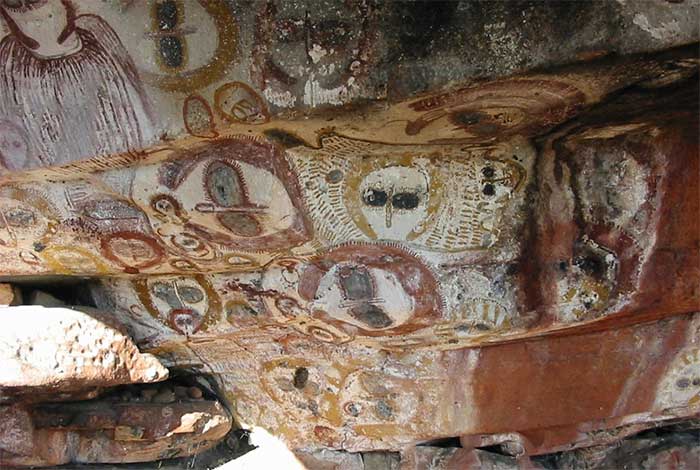Could 4,000-year-old Aboriginal cave paintings in Australia really depict aliens?
If you are interested in ancient mysteries and legends, you may have heard of the Wandjinas , the supreme deities and creators of the land and people in Australian Aboriginal mythology. The Wandjinas are depicted in some of the oldest and most fascinating rock art found in Australia, particularly in the Kimberley region of Western Australia.
The Wandjina are also known as Gulingi by the Wunambal people of the Mitchell Plateau . They are believed to be cloud and rain spirits who came from the Milky Way during the Dreamtime (the origin of Aboriginal people) and created the Earth and all its inhabitants. They also taught Aboriginal people their laws, customs, ceremonies and how to live in harmony with nature. The Wandjinas are associated with water, fertility and power, and they can punish those who break their laws with floods, lightning and tornadoes.

The image has been widely circulated on social media and conspiracy theory websites with claims that these 5,000 (actually 4,000) year old Aboriginal rock paintings actually depict aliens – but do they really?
The Wandjina rock art paintings date back around 4,000 years and were created after a drought that lasted for millennia and ended with the arrival of a wetter climate, characterised by regular monsoons. The paintings are found on rocks and caves throughout the Kimberley region, and are still considered sacred by the Worrorra, Ngarinyin and Wunambal people , the custodians of the land. The paintings are periodically renewed by Aboriginal people as a way of re-energising the Wandjinas.
The paintings have a distinctive style and characteristics. They often have large torsos and heads with large black eyes and what looks like a halo or helmet around them. They have no mouths, and according to local legend, this is explained by two reasons: one is that they are so powerful that they do not need words; the other is that if they had mouths, the rain would never stop. The paintings also show figures and objects associated with the Wandjinas, such as the Rainbow Serpent, boomerangs and stone axes.

The paintings have their own distinct style and characteristics. (Illustration).
The Wandjina rock art paintings have attracted many interpretations and speculations from many different sources. Some see them as stylized representations of humans or animals (such as owls), while others see them as symbols of strength and spiritual power. And some even think they may depict aliens.
The white face, large black eyes and long nose with which the Wandjina are often depicted have led some to suggest that these features resemble extraterrestrial beings and that the Wandjina may have been ancient visitors from outer space. Some have even suggested that the halo or helmet around the Wandjina's head is a sign of advanced technology or knowledge and that aliens may have been actively involved in the creation process – a concept that is reflected not only in Indigenous Australian Dreamtime narratives but also in mythology.

Many people believe that the Wandjina rock art depicts aliens. (Illustration photo).
As for the role of the Wandjinas in the Aboriginal creation story, the 'sky beings' or 'spirits from the clouds' are said to have descended from the Milky Way during the Dreamtime to shape the Earth and its inhabitants. Realizing the importance of their mission, they returned home to bring more Wandjina with them. Aided by the Dreamtime serpent, they descended again, spending their time as creators, teachers and deities to the Aboriginal people they had created.
Eventually, the Wandjinas disappear, going underground and residing at the bottom of the water source associated with each painting. There, they constantly create new 'seeds', which are considered the source of all human life.
Many other reasonable questions arise, such as why the Wandjina are depicted with white skin while the Aborigines are depicted with black skin. Then there is the disproportionate size of the eyes compared to the face and nose, and of course, the consistent absence of mouths in the depictions that we have already mentioned.


The Wandjina rock art is evidence of the complex culture of the Aboriginal people. (Illustration photo).
But while the resemblance between the Wandjina and typical extraterrestrial imagery in art, film and eyewitness accounts is striking, there is absolutely no evidence to support the extraterrestrial hypothesis and it would also be disrespectful to Indigenous Australians who regard the Wandjina as sacred ancestral spirits.
Whatever the truth, the Wandjina rock art paintings are a remarkable testament to the rich and complex culture and history of Aboriginal people. They reflect their deep connection to the land, their ancestors and their spirituality. They also challenge us to broaden our perspective and question our assumptions about humanity's past, present and future.
- The wasps' hives help determine the age of cave paintings in Australia
- The oldest rock art in Australia
- Mysterious aboriginal figure in Australia
- Find the world's oldest artwork in a cave in Indonesia
- Mexico discovered 5000 ancient paintings in the cave
- When did the first Aboriginal people arrive in Australia?
- The sun 'imitates' the aboriginal flag in the bushfire in Australia
- Mysterious Aboriginal drawing 4.2km long in the Australian desert
- The truth about the mysterious red-haired giant at Lovelock Cave
- Mysterious handprints in ancient cave
- The 50,000-year-old method can extinguish Australian forest fires
- Aboriginal Australians represent the oldest civilization on Earth
 The truth about the mysterious red-haired giant at Lovelock Cave
The truth about the mysterious red-haired giant at Lovelock Cave Inunaki Tunnel: The haunted road leading into Japan's 'village of death'
Inunaki Tunnel: The haunted road leading into Japan's 'village of death' The mystery of the phenomenon of human reflection before dying
The mystery of the phenomenon of human reflection before dying 6 mysterious phenomena, although science has been developed for a long time, still cannot be answered
6 mysterious phenomena, although science has been developed for a long time, still cannot be answered